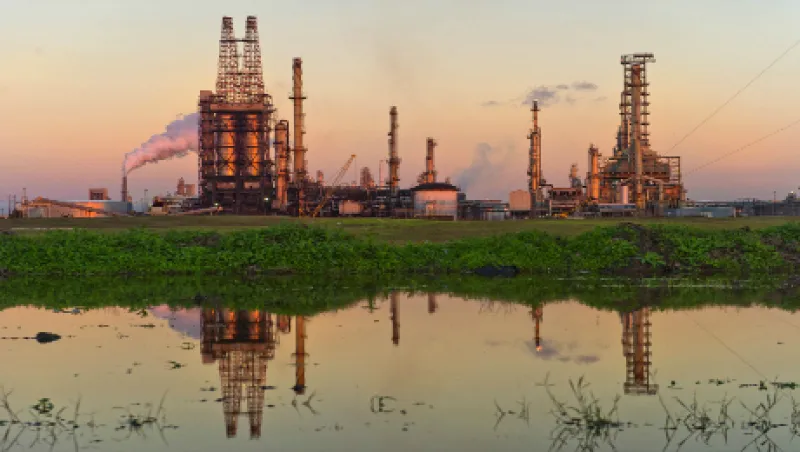After the recent uptick in petroleum prices, the U.S. oil and gas industry still finds itself east of Rock and west of Hard Place. Oil production has declined only slightly since last April, according to the Washington-based U.S. Energy Information Administration. Prices could fall again due to excess supply, but no one knows if that will happen. Despite this uncertainty, some asset managers are finding opportunities.
“We actually think this is one of the better times to invest in energy,” says Stan Majcher, principal and portfolio manager at Los Angeles–based Hotchkis and Wiley Capital Management. Majcher, whose $28 billion firm’s domestic oil and gas positions include Marathon Oil Corp. and Murphy Oil Corp., according to regulatory filings, expects U.S. production to drop in the second half of this year.
It’s increasingly likely that the market will be undersupplied by 2017, he believes. “There’s no doubt that the industry is under stress in the U.S., but there are other geographies that are worse off,” Majcher says. “We think the U.S. is in the middle of the cost curve.”
If Majcher’s forecast holds true, U.S. explorers and producers will need time to come back online, which could keep prices elevated. “You have to assess whether people who have already been laid off are still looking for work,” he explains. “They might not even be in the industry anymore. It’s going to take the time to fill those spots and stand those rigs up again.” By getting in now, investors can take advantage of any price increases later on, Majcher argues.
Many have already taken the plunge. Intercontinental Exchange’s “Commitments of Traders” report for the week ended February 23 shows that hedge funds have broadly increased their long positions in oil and gas worldwide, with the number of firms reporting positive bets at its highest since records began in 2011.
Investors are looking for U.S. companies with enough strength and liquidity to stay afloat until supply starts pulling even with demand, which could happen by 2018. William Costello, senior portfolio manager at Dallas-based Westwood Holdings Group, a $20.8 billion asset manager, cut back on his oil and gas positions at the start of the drawdown but says some areas will be able to survive even with lower prices over the long term. “We see opportunities in companies that operate in the Permian,” he explains.
Westwood has stakes in oil producers Callon Petroleum Co. and RSP Permian, both of which operate in the Permian Basin of West Texas, one of the largest U.S. regions for shale oil and gas. Costello says his firm is also looking at natural-gas companies in the Marcellus shale region of Appalachia.
In both areas production remains profitable at today’s prices, and the most speculative projects have been put off for the foreseeable future, he notes. Pittsburgh-based EQT Midstream Partners, a specialist in oil transmission and storage, has emerged as a favorite among U.S. hedge fund managers looking at the Marcellus: Citadel, Kayne Anderson Capital Advisors, Millennium Management and Zimmer Partners all hold stakes in EQT.
Denbury Resources, which has oil and gas operations in the Rocky Mountains and on the Gulf Coast, is another hedge fund favorite. Regulatory filings show that U.S. firms Bridgewater Associates and Millennium and London-based Marshall Wace own positions. Plano, Texas–headquartered Denbury falls into the high-yield category, with a Caa2/CCC rating that deems it at risk of bankruptcy.
But Leslie Biddle, partner at Serengeti Asset Management, a New York–based firm with about $1 billion in assets, points out that Denbury is still operating on cash and can tap an untouched line of credit: “It has enough liquidity that it could make it.”
Without any new exploration, U.S. oil and gas production will decline by 8 to 10 percent a year, Biddle notes. “So the market moves toward rebalancing on its own,” she says. “To make the most of these opportunities, you have to consider that and capture the value while prices are low.”
Although these companies seem strong enough to survive, ratings agencies are making it harder to analyze several others. In late February, Moody’s Investors Service downgraded 38 U.S. and Canadian oil and gas companies to speculative and high-yield, citing default risk and lower pricing expectations. However, Fitch Ratings and Standard & Poor’s didn’t agree. Now players like Oklahoma City, Oklahoma–based Devon Energy Corp. have a split rating even though they’re still included in the investment-grade index.
There’s a simple reason for this discrepancy. “When we embarked on the ratings actions, we only looked at 2016 and 2017,” explains RJ Cruz, a New York–based senior analyst in the fixed-income group at Moody’s. “The other ratings agencies are using a different price deck, which also takes 2018 into account.”
With consensus building that 2018 will be the earliest that supply and demand start to balance out, factoring that year into a ratings model could make a material difference in whether a company keeps its investment-grade status. But even for businesses that can avoid a downgrade, things still look dire in the short run, Cruz observes. “We don’t see how a lot of these E&P companies can survive with $33 oil,” he says. “Even in 2018, pricing is not going to be significantly above that level.”
The upside for the 38 names on the ratings bubble: They just became more interesting to some investors. “What you have is a situation where some funds won’t invest in these companies because of the split rating, and then they start to get priced like junk, which creates a value opportunity,” says Serengeti’s Biddle.
Ratings agencies consider a range of metrics including leverage, cash flow and debt before downgrading a company. Potential investors have to run the same analysis to see if they agree. But with a volatile asset like oil at the core of these businesses, Biddle says it can be tough to call a bottom, and that’s keeping some people on the sidelines. “Until the commodity price stabilizes, you’re not going to see that wall of capital looking for distressed opportunities come into the market,” she predicts. •






